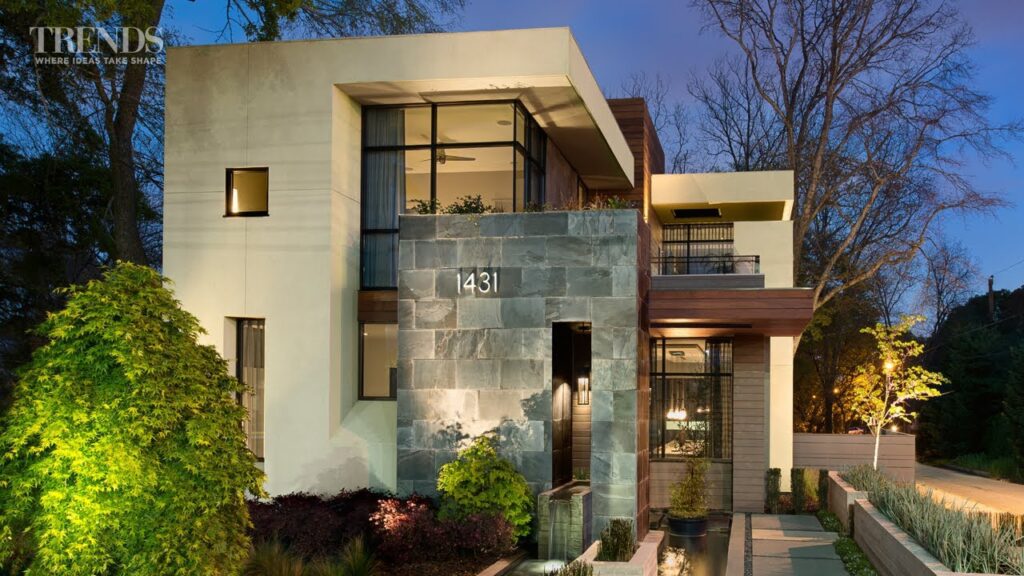Architecture constantly evolves, reflecting societal changes, technological advancements, and environmental concerns. As we move into 2024, a series of innovative trends are shaping the way we design, build, and inhabit spaces. From sustainability to smart integration, here are the key architectural trends defining the modern era.

1. Sustainability at the Core
Sustainability is no longer optional in architecture; it is a necessity. In 2024, green buildings are setting the benchmark. Architects are leveraging energy-efficient designs, renewable energy sources, and sustainable materials. Passive solar designs, green roofs, and rainwater harvesting systems are becoming standard features. Moreover, carbon-neutral buildings aim to minimize environmental footprints by balancing carbon emissions through renewable energy and energy-efficient construction techniques.
2. Biophilic Design
The biophilic design trend continues to flourish, emphasizing the connection between humans and nature. Incorporating natural elements such as indoor gardens, water features, and large windows to maximize natural light has become integral to creating healthier and more inspiring living environments. This approach not only enhances mental well-being but also improves air quality and reduces stress.
3. Smart Homes and Buildings
The integration of technology in architecture is reaching new heights. In 2024, smart homes will feature advanced automation systems for lighting, temperature, and security, all controlled via smartphones or voice commands. Buildings are equipped with sensors to optimise energy usage, monitor structural health, and enhance occupant comfort. The Internet of Things (IoT) is making buildings smarter and more responsive to user needs.
4. Flexible and Multi-Functional Spaces
The rise of remote work and dynamic lifestyles has shifted the focus to adaptable spaces. Modern architecture embraces multi-functional rooms that can transform from home offices to leisure spaces effortlessly. Movable walls, modular furniture, and convertible layouts are becoming more common, offering flexibility for urban dwellers in smaller apartments.
5. Minimalism with a Twist
Minimalism remains a strong influence but with added warmth and texture. Clean lines, neutral palettes, and uncluttered spaces are enhanced with natural materials like wood, stone, and textiles. The interplay of light and shadow, along with curated artwork and statement pieces, adds character to minimalist designs, making them feel cosy yet sophisticated.
6. Circular Economy and Upcycling
In response to environmental concerns, architects are adopting circular economy principles. This involves designing buildings that can be easily disassembled and reused. Upcycling materials—like using reclaimed wood, recycled steel, or repurposed concrete—is becoming widespread. This trend not only reduces waste but also adds a unique aesthetic to structures.
7. Urban Green Spaces
With increasing urbanisation, integrating green spaces into architectural designs is crucial. Rooftop gardens, vertical forests, and community parks are redefining cityscapes. These spaces provide ecological benefits, improve urban air quality, and create areas for relaxation and social interaction. Urban planners and architects collaborate to incorporate nature seamlessly into densely populated areas.
8. Focus on Wellness
Wellness-centric architecture prioritises the physical and mental health of occupants. Features like soundproofing, air purification systems, ergonomic designs, and circadian lighting create environments conducive to well-being. Wellness certifications, such as WELL and Fitwel, are gaining traction as architects strive to align with health-focused design standards.
9. Hybrid and Prefabricated Construction
Hybrid construction methods—combining traditional techniques with prefabrication—are gaining momentum. Prefabricated components reduce construction time and costs while maintaining high-quality standards. This approach also allows for greater precision and less on-site waste, aligning with sustainability goals.
10. Cultural Context and Local Identity
Incorporating cultural heritage and local identity into modern designs is becoming increasingly important. Architects are blending contemporary aesthetics with traditional techniques and materials, creating structures that honor their surroundings. This approach fosters a sense of belonging and enriches the architectural narrative.
11. Parametric Design and AI
Technology continues to revolutionise architecture through parametric design and artificial intelligence (AI). Parametric tools allow architects to create complex and efficient designs by manipulating parameters. AI enhances decision-making by analysing data for optimal designs, energy efficiency, and material selection. This fusion of technology and creativity is pushing the boundaries of what’s possible in architecture.
12. Resilient Architecture
In an era of climate change, resilience is a top priority. Architects are designing buildings to withstand natural disasters such as floods, earthquakes, and hurricanes. Elevated foundations, flood-proof materials, and energy self-sufficiency are integral to resilient designs. These features ensure safety and longevity in an unpredictable environment.
13. 3D Printing in Construction
3D printing is revolutionising construction by enabling the rapid production of building components. This technology reduces waste, speeds up construction, and allows for intricate designs that would be difficult or costly to achieve using traditional methods. In 2024, we see 3D-printed homes gaining mainstream acceptance.
Conclusion
The architectural trends of 2024 showcase a harmonious blend of technology, sustainability, and human-centric design. As architects address global challenges and innovate for the future, these trends reflect a commitment to creating spaces that are not only functional and beautiful but also aligned with the values of a rapidly evolving world.


Pingback: Architectural firms in coimbatore
Pingback: Contemporary Architecture Styles